Effective Leadership and Motivation Strategies in Global Management
VerifiedAdded on 2020/03/23
|14
|3741
|32
Report
AI Summary
This report provides a comprehensive overview of motivation and leadership within an international context. It begins by defining motivation and leadership, emphasizing their cultural dependencies. The report then delves into the impact of culture on these elements, highlighting the significance of understanding diverse employee perspectives. It explores key motivational theories, including Hofstede's research, Maslow's hierarchy, and Herzberg's theory, analyzing their application in global settings. Furthermore, it discusses strategies for motivating employees across different cultural backgrounds. The report also examines leadership at the global level, addressing challenges such as global complexity and connectivity, and explores various leadership approaches. The role of technology in facilitating global leadership is also considered. Overall, the report offers valuable insights into managing effectively across international borders, emphasizing the need for culturally sensitive leadership and motivational strategies to achieve organizational success in a globalized environment.
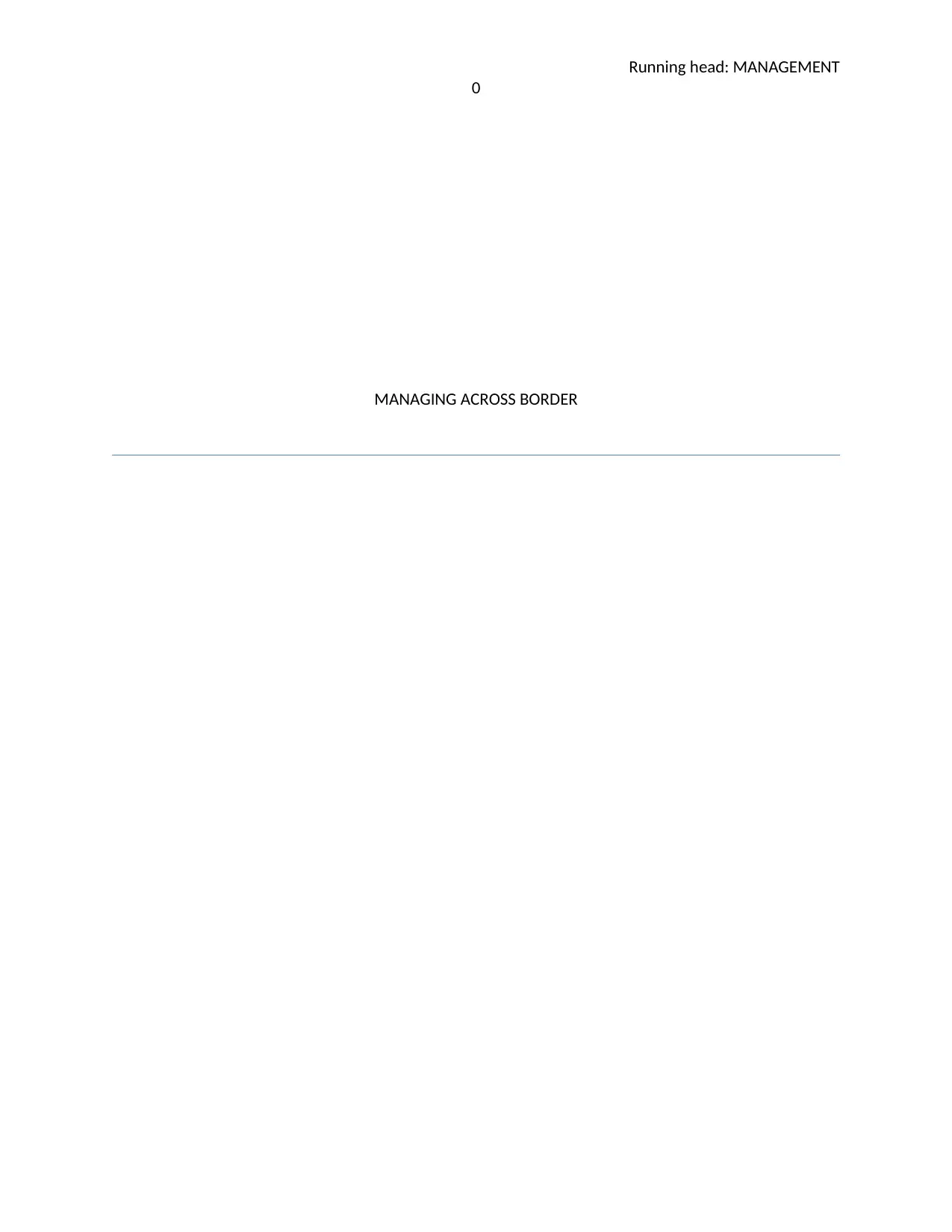
Running head: MANAGEMENT
0
MANAGING ACROSS BORDER
0
MANAGING ACROSS BORDER
Paraphrase This Document
Need a fresh take? Get an instant paraphrase of this document with our AI Paraphraser
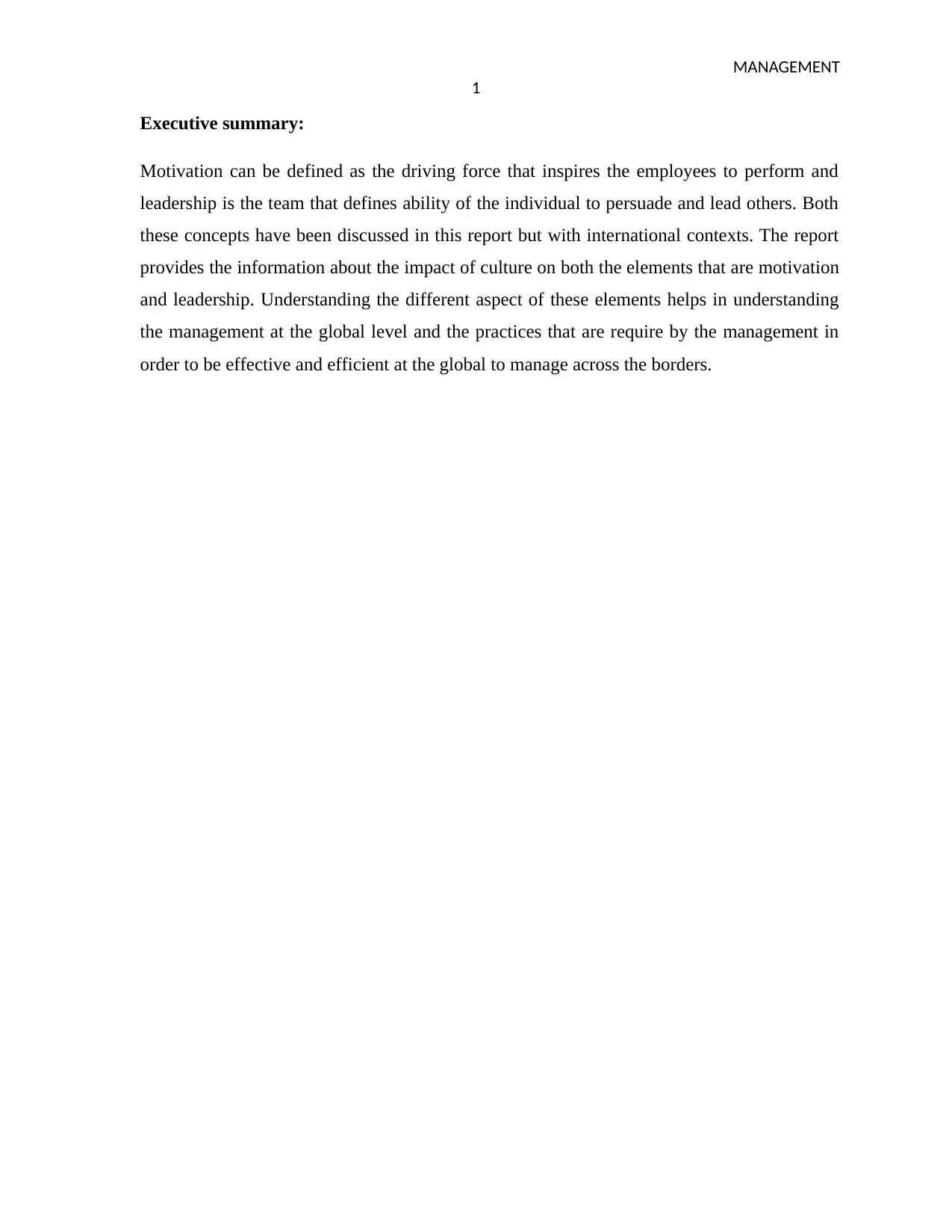
MANAGEMENT
1
Executive summary:
Motivation can be defined as the driving force that inspires the employees to perform and
leadership is the team that defines ability of the individual to persuade and lead others. Both
these concepts have been discussed in this report but with international contexts. The report
provides the information about the impact of culture on both the elements that are motivation
and leadership. Understanding the different aspect of these elements helps in understanding
the management at the global level and the practices that are require by the management in
order to be effective and efficient at the global to manage across the borders.
1
Executive summary:
Motivation can be defined as the driving force that inspires the employees to perform and
leadership is the team that defines ability of the individual to persuade and lead others. Both
these concepts have been discussed in this report but with international contexts. The report
provides the information about the impact of culture on both the elements that are motivation
and leadership. Understanding the different aspect of these elements helps in understanding
the management at the global level and the practices that are require by the management in
order to be effective and efficient at the global to manage across the borders.
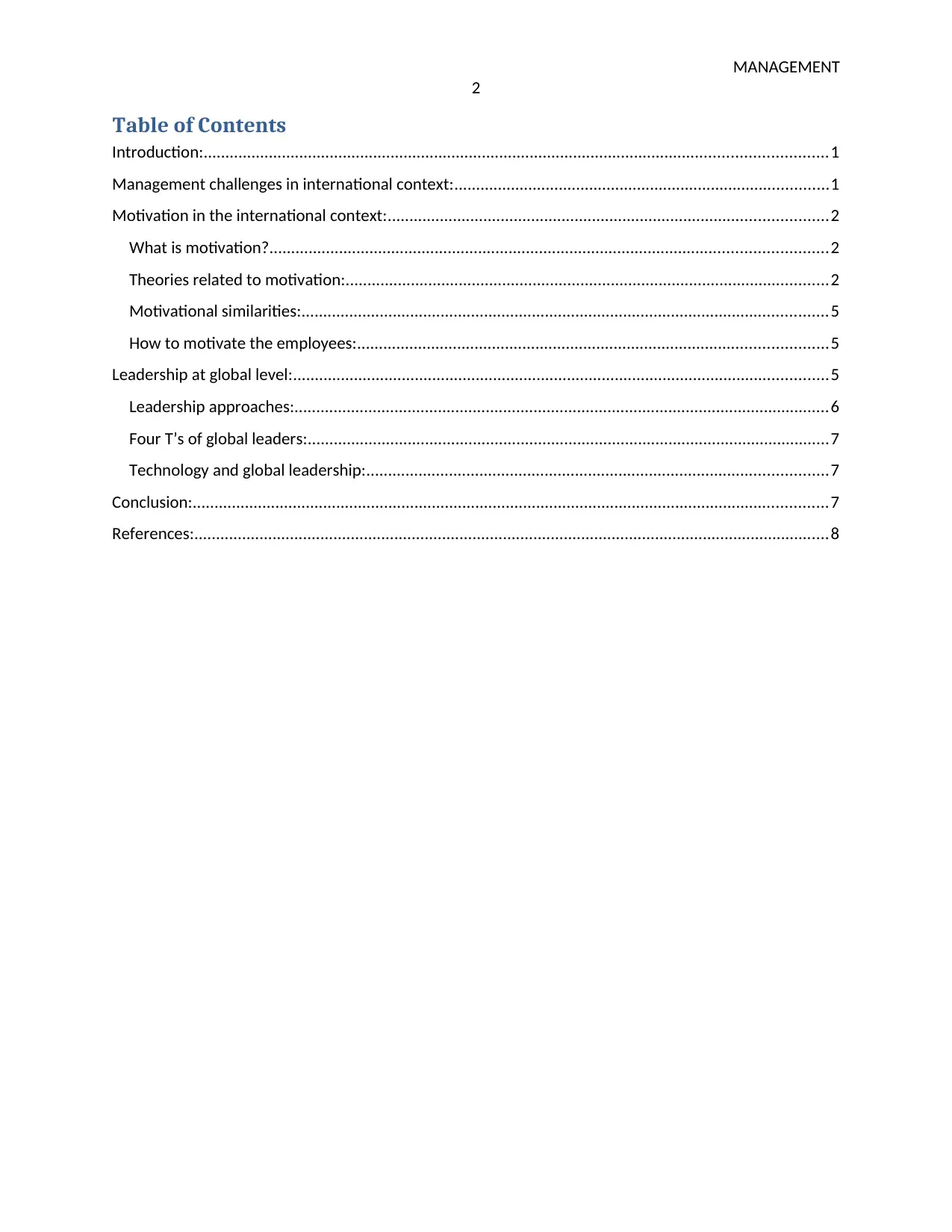
MANAGEMENT
2
Table of Contents
Introduction:...............................................................................................................................................1
Management challenges in international context:......................................................................................1
Motivation in the international context:.....................................................................................................2
What is motivation?................................................................................................................................2
Theories related to motivation:...............................................................................................................2
Motivational similarities:.........................................................................................................................5
How to motivate the employees:............................................................................................................5
Leadership at global level:...........................................................................................................................5
Leadership approaches:...........................................................................................................................6
Four T’s of global leaders:........................................................................................................................7
Technology and global leadership:..........................................................................................................7
Conclusion:..................................................................................................................................................7
References:..................................................................................................................................................8
2
Table of Contents
Introduction:...............................................................................................................................................1
Management challenges in international context:......................................................................................1
Motivation in the international context:.....................................................................................................2
What is motivation?................................................................................................................................2
Theories related to motivation:...............................................................................................................2
Motivational similarities:.........................................................................................................................5
How to motivate the employees:............................................................................................................5
Leadership at global level:...........................................................................................................................5
Leadership approaches:...........................................................................................................................6
Four T’s of global leaders:........................................................................................................................7
Technology and global leadership:..........................................................................................................7
Conclusion:..................................................................................................................................................7
References:..................................................................................................................................................8
⊘ This is a preview!⊘
Do you want full access?
Subscribe today to unlock all pages.

Trusted by 1+ million students worldwide
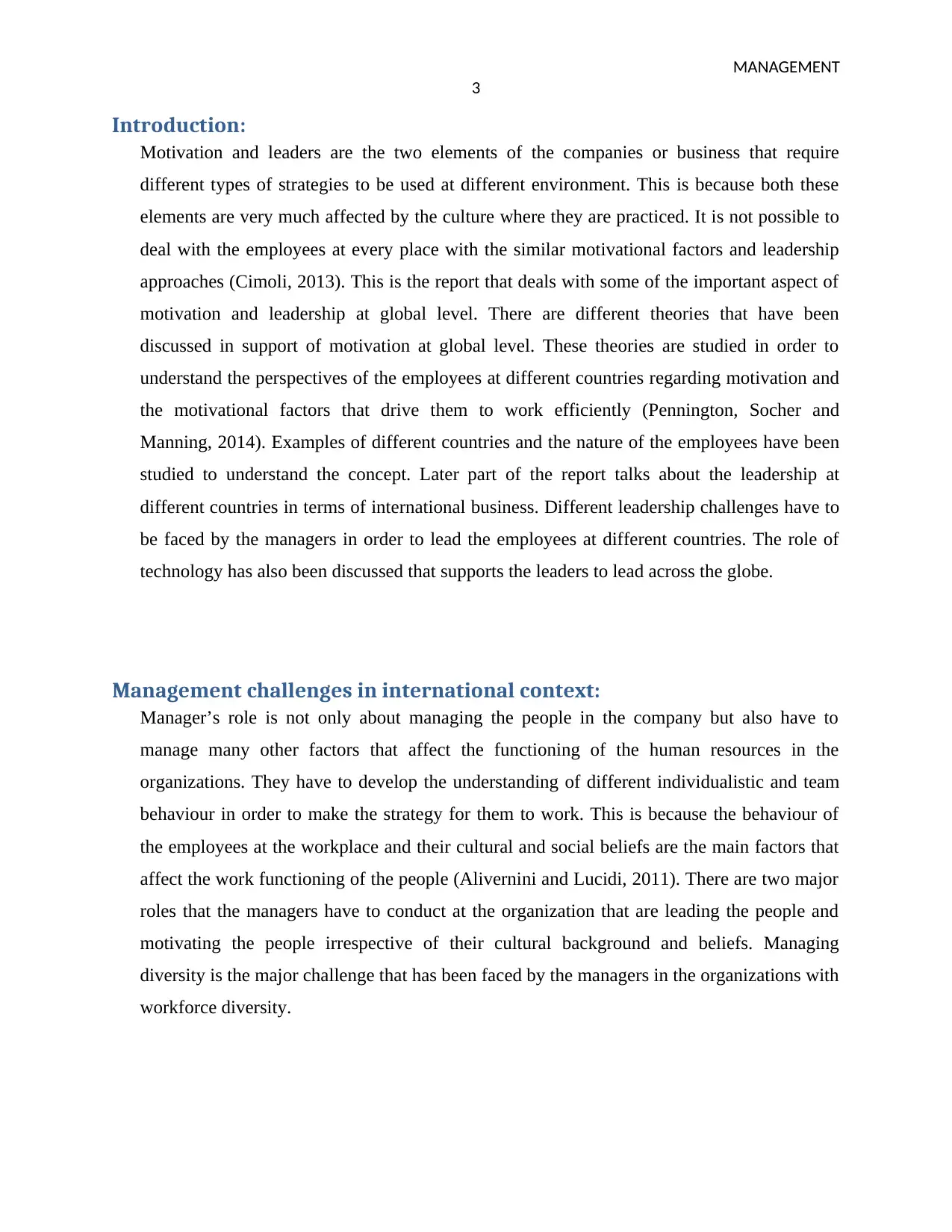
MANAGEMENT
3
Introduction:
Motivation and leaders are the two elements of the companies or business that require
different types of strategies to be used at different environment. This is because both these
elements are very much affected by the culture where they are practiced. It is not possible to
deal with the employees at every place with the similar motivational factors and leadership
approaches (Cimoli, 2013). This is the report that deals with some of the important aspect of
motivation and leadership at global level. There are different theories that have been
discussed in support of motivation at global level. These theories are studied in order to
understand the perspectives of the employees at different countries regarding motivation and
the motivational factors that drive them to work efficiently (Pennington, Socher and
Manning, 2014). Examples of different countries and the nature of the employees have been
studied to understand the concept. Later part of the report talks about the leadership at
different countries in terms of international business. Different leadership challenges have to
be faced by the managers in order to lead the employees at different countries. The role of
technology has also been discussed that supports the leaders to lead across the globe.
Management challenges in international context:
Manager’s role is not only about managing the people in the company but also have to
manage many other factors that affect the functioning of the human resources in the
organizations. They have to develop the understanding of different individualistic and team
behaviour in order to make the strategy for them to work. This is because the behaviour of
the employees at the workplace and their cultural and social beliefs are the main factors that
affect the work functioning of the people (Alivernini and Lucidi, 2011). There are two major
roles that the managers have to conduct at the organization that are leading the people and
motivating the people irrespective of their cultural background and beliefs. Managing
diversity is the major challenge that has been faced by the managers in the organizations with
workforce diversity.
3
Introduction:
Motivation and leaders are the two elements of the companies or business that require
different types of strategies to be used at different environment. This is because both these
elements are very much affected by the culture where they are practiced. It is not possible to
deal with the employees at every place with the similar motivational factors and leadership
approaches (Cimoli, 2013). This is the report that deals with some of the important aspect of
motivation and leadership at global level. There are different theories that have been
discussed in support of motivation at global level. These theories are studied in order to
understand the perspectives of the employees at different countries regarding motivation and
the motivational factors that drive them to work efficiently (Pennington, Socher and
Manning, 2014). Examples of different countries and the nature of the employees have been
studied to understand the concept. Later part of the report talks about the leadership at
different countries in terms of international business. Different leadership challenges have to
be faced by the managers in order to lead the employees at different countries. The role of
technology has also been discussed that supports the leaders to lead across the globe.
Management challenges in international context:
Manager’s role is not only about managing the people in the company but also have to
manage many other factors that affect the functioning of the human resources in the
organizations. They have to develop the understanding of different individualistic and team
behaviour in order to make the strategy for them to work. This is because the behaviour of
the employees at the workplace and their cultural and social beliefs are the main factors that
affect the work functioning of the people (Alivernini and Lucidi, 2011). There are two major
roles that the managers have to conduct at the organization that are leading the people and
motivating the people irrespective of their cultural background and beliefs. Managing
diversity is the major challenge that has been faced by the managers in the organizations with
workforce diversity.
Paraphrase This Document
Need a fresh take? Get an instant paraphrase of this document with our AI Paraphraser
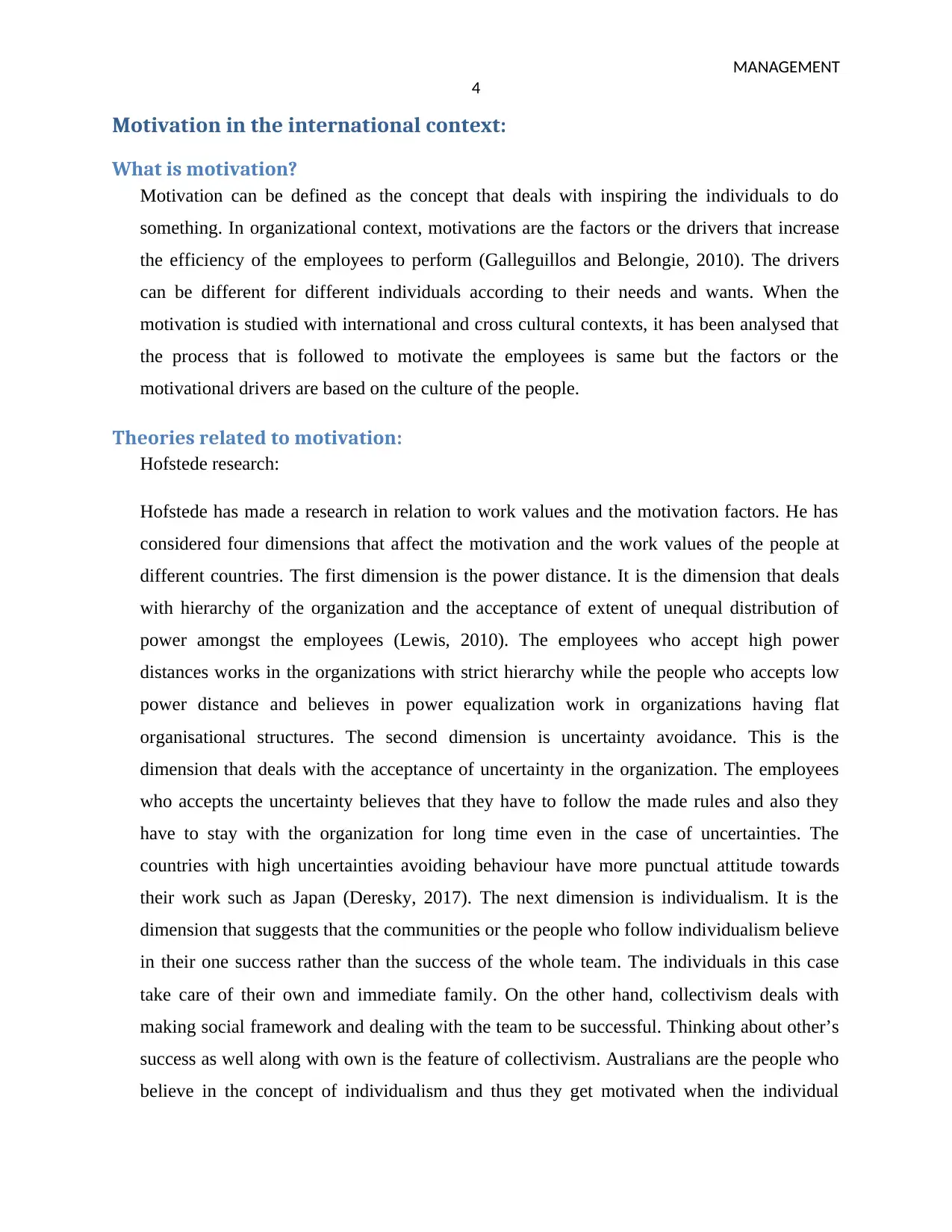
MANAGEMENT
4
Motivation in the international context:
What is motivation?
Motivation can be defined as the concept that deals with inspiring the individuals to do
something. In organizational context, motivations are the factors or the drivers that increase
the efficiency of the employees to perform (Galleguillos and Belongie, 2010). The drivers
can be different for different individuals according to their needs and wants. When the
motivation is studied with international and cross cultural contexts, it has been analysed that
the process that is followed to motivate the employees is same but the factors or the
motivational drivers are based on the culture of the people.
Theories related to motivation:
Hofstede research:
Hofstede has made a research in relation to work values and the motivation factors. He has
considered four dimensions that affect the motivation and the work values of the people at
different countries. The first dimension is the power distance. It is the dimension that deals
with hierarchy of the organization and the acceptance of extent of unequal distribution of
power amongst the employees (Lewis, 2010). The employees who accept high power
distances works in the organizations with strict hierarchy while the people who accepts low
power distance and believes in power equalization work in organizations having flat
organisational structures. The second dimension is uncertainty avoidance. This is the
dimension that deals with the acceptance of uncertainty in the organization. The employees
who accepts the uncertainty believes that they have to follow the made rules and also they
have to stay with the organization for long time even in the case of uncertainties. The
countries with high uncertainties avoiding behaviour have more punctual attitude towards
their work such as Japan (Deresky, 2017). The next dimension is individualism. It is the
dimension that suggests that the communities or the people who follow individualism believe
in their one success rather than the success of the whole team. The individuals in this case
take care of their own and immediate family. On the other hand, collectivism deals with
making social framework and dealing with the team to be successful. Thinking about other’s
success as well along with own is the feature of collectivism. Australians are the people who
believe in the concept of individualism and thus they get motivated when the individual
4
Motivation in the international context:
What is motivation?
Motivation can be defined as the concept that deals with inspiring the individuals to do
something. In organizational context, motivations are the factors or the drivers that increase
the efficiency of the employees to perform (Galleguillos and Belongie, 2010). The drivers
can be different for different individuals according to their needs and wants. When the
motivation is studied with international and cross cultural contexts, it has been analysed that
the process that is followed to motivate the employees is same but the factors or the
motivational drivers are based on the culture of the people.
Theories related to motivation:
Hofstede research:
Hofstede has made a research in relation to work values and the motivation factors. He has
considered four dimensions that affect the motivation and the work values of the people at
different countries. The first dimension is the power distance. It is the dimension that deals
with hierarchy of the organization and the acceptance of extent of unequal distribution of
power amongst the employees (Lewis, 2010). The employees who accept high power
distances works in the organizations with strict hierarchy while the people who accepts low
power distance and believes in power equalization work in organizations having flat
organisational structures. The second dimension is uncertainty avoidance. This is the
dimension that deals with the acceptance of uncertainty in the organization. The employees
who accepts the uncertainty believes that they have to follow the made rules and also they
have to stay with the organization for long time even in the case of uncertainties. The
countries with high uncertainties avoiding behaviour have more punctual attitude towards
their work such as Japan (Deresky, 2017). The next dimension is individualism. It is the
dimension that suggests that the communities or the people who follow individualism believe
in their one success rather than the success of the whole team. The individuals in this case
take care of their own and immediate family. On the other hand, collectivism deals with
making social framework and dealing with the team to be successful. Thinking about other’s
success as well along with own is the feature of collectivism. Australians are the people who
believe in the concept of individualism and thus they get motivated when the individual
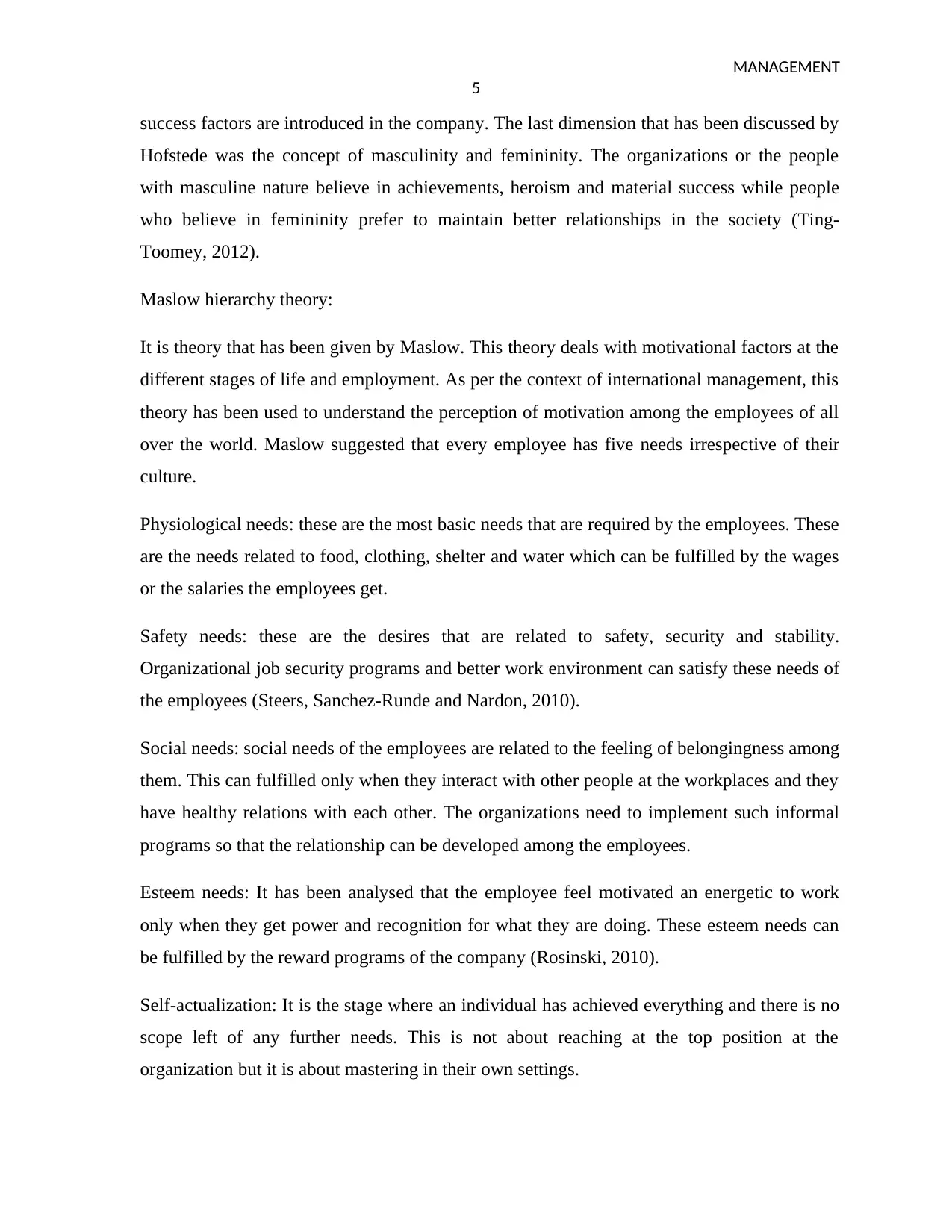
MANAGEMENT
5
success factors are introduced in the company. The last dimension that has been discussed by
Hofstede was the concept of masculinity and femininity. The organizations or the people
with masculine nature believe in achievements, heroism and material success while people
who believe in femininity prefer to maintain better relationships in the society (Ting-
Toomey, 2012).
Maslow hierarchy theory:
It is theory that has been given by Maslow. This theory deals with motivational factors at the
different stages of life and employment. As per the context of international management, this
theory has been used to understand the perception of motivation among the employees of all
over the world. Maslow suggested that every employee has five needs irrespective of their
culture.
Physiological needs: these are the most basic needs that are required by the employees. These
are the needs related to food, clothing, shelter and water which can be fulfilled by the wages
or the salaries the employees get.
Safety needs: these are the desires that are related to safety, security and stability.
Organizational job security programs and better work environment can satisfy these needs of
the employees (Steers, Sanchez-Runde and Nardon, 2010).
Social needs: social needs of the employees are related to the feeling of belongingness among
them. This can fulfilled only when they interact with other people at the workplaces and they
have healthy relations with each other. The organizations need to implement such informal
programs so that the relationship can be developed among the employees.
Esteem needs: It has been analysed that the employee feel motivated an energetic to work
only when they get power and recognition for what they are doing. These esteem needs can
be fulfilled by the reward programs of the company (Rosinski, 2010).
Self-actualization: It is the stage where an individual has achieved everything and there is no
scope left of any further needs. This is not about reaching at the top position at the
organization but it is about mastering in their own settings.
5
success factors are introduced in the company. The last dimension that has been discussed by
Hofstede was the concept of masculinity and femininity. The organizations or the people
with masculine nature believe in achievements, heroism and material success while people
who believe in femininity prefer to maintain better relationships in the society (Ting-
Toomey, 2012).
Maslow hierarchy theory:
It is theory that has been given by Maslow. This theory deals with motivational factors at the
different stages of life and employment. As per the context of international management, this
theory has been used to understand the perception of motivation among the employees of all
over the world. Maslow suggested that every employee has five needs irrespective of their
culture.
Physiological needs: these are the most basic needs that are required by the employees. These
are the needs related to food, clothing, shelter and water which can be fulfilled by the wages
or the salaries the employees get.
Safety needs: these are the desires that are related to safety, security and stability.
Organizational job security programs and better work environment can satisfy these needs of
the employees (Steers, Sanchez-Runde and Nardon, 2010).
Social needs: social needs of the employees are related to the feeling of belongingness among
them. This can fulfilled only when they interact with other people at the workplaces and they
have healthy relations with each other. The organizations need to implement such informal
programs so that the relationship can be developed among the employees.
Esteem needs: It has been analysed that the employee feel motivated an energetic to work
only when they get power and recognition for what they are doing. These esteem needs can
be fulfilled by the reward programs of the company (Rosinski, 2010).
Self-actualization: It is the stage where an individual has achieved everything and there is no
scope left of any further needs. This is not about reaching at the top position at the
organization but it is about mastering in their own settings.
⊘ This is a preview!⊘
Do you want full access?
Subscribe today to unlock all pages.

Trusted by 1+ million students worldwide
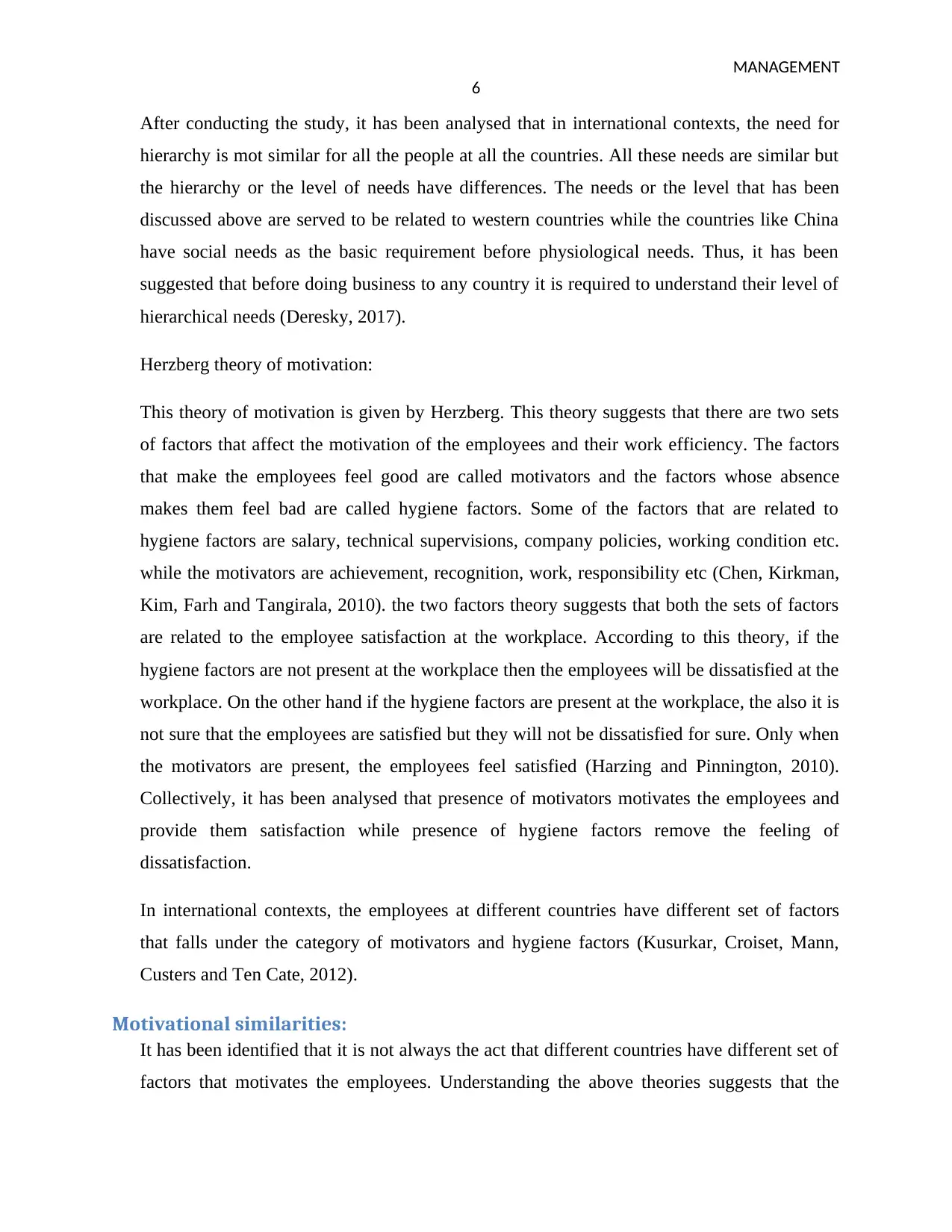
MANAGEMENT
6
After conducting the study, it has been analysed that in international contexts, the need for
hierarchy is mot similar for all the people at all the countries. All these needs are similar but
the hierarchy or the level of needs have differences. The needs or the level that has been
discussed above are served to be related to western countries while the countries like China
have social needs as the basic requirement before physiological needs. Thus, it has been
suggested that before doing business to any country it is required to understand their level of
hierarchical needs (Deresky, 2017).
Herzberg theory of motivation:
This theory of motivation is given by Herzberg. This theory suggests that there are two sets
of factors that affect the motivation of the employees and their work efficiency. The factors
that make the employees feel good are called motivators and the factors whose absence
makes them feel bad are called hygiene factors. Some of the factors that are related to
hygiene factors are salary, technical supervisions, company policies, working condition etc.
while the motivators are achievement, recognition, work, responsibility etc (Chen, Kirkman,
Kim, Farh and Tangirala, 2010). the two factors theory suggests that both the sets of factors
are related to the employee satisfaction at the workplace. According to this theory, if the
hygiene factors are not present at the workplace then the employees will be dissatisfied at the
workplace. On the other hand if the hygiene factors are present at the workplace, the also it is
not sure that the employees are satisfied but they will not be dissatisfied for sure. Only when
the motivators are present, the employees feel satisfied (Harzing and Pinnington, 2010).
Collectively, it has been analysed that presence of motivators motivates the employees and
provide them satisfaction while presence of hygiene factors remove the feeling of
dissatisfaction.
In international contexts, the employees at different countries have different set of factors
that falls under the category of motivators and hygiene factors (Kusurkar, Croiset, Mann,
Custers and Ten Cate, 2012).
Motivational similarities:
It has been identified that it is not always the act that different countries have different set of
factors that motivates the employees. Understanding the above theories suggests that the
6
After conducting the study, it has been analysed that in international contexts, the need for
hierarchy is mot similar for all the people at all the countries. All these needs are similar but
the hierarchy or the level of needs have differences. The needs or the level that has been
discussed above are served to be related to western countries while the countries like China
have social needs as the basic requirement before physiological needs. Thus, it has been
suggested that before doing business to any country it is required to understand their level of
hierarchical needs (Deresky, 2017).
Herzberg theory of motivation:
This theory of motivation is given by Herzberg. This theory suggests that there are two sets
of factors that affect the motivation of the employees and their work efficiency. The factors
that make the employees feel good are called motivators and the factors whose absence
makes them feel bad are called hygiene factors. Some of the factors that are related to
hygiene factors are salary, technical supervisions, company policies, working condition etc.
while the motivators are achievement, recognition, work, responsibility etc (Chen, Kirkman,
Kim, Farh and Tangirala, 2010). the two factors theory suggests that both the sets of factors
are related to the employee satisfaction at the workplace. According to this theory, if the
hygiene factors are not present at the workplace then the employees will be dissatisfied at the
workplace. On the other hand if the hygiene factors are present at the workplace, the also it is
not sure that the employees are satisfied but they will not be dissatisfied for sure. Only when
the motivators are present, the employees feel satisfied (Harzing and Pinnington, 2010).
Collectively, it has been analysed that presence of motivators motivates the employees and
provide them satisfaction while presence of hygiene factors remove the feeling of
dissatisfaction.
In international contexts, the employees at different countries have different set of factors
that falls under the category of motivators and hygiene factors (Kusurkar, Croiset, Mann,
Custers and Ten Cate, 2012).
Motivational similarities:
It has been identified that it is not always the act that different countries have different set of
factors that motivates the employees. Understanding the above theories suggests that the
Paraphrase This Document
Need a fresh take? Get an instant paraphrase of this document with our AI Paraphraser
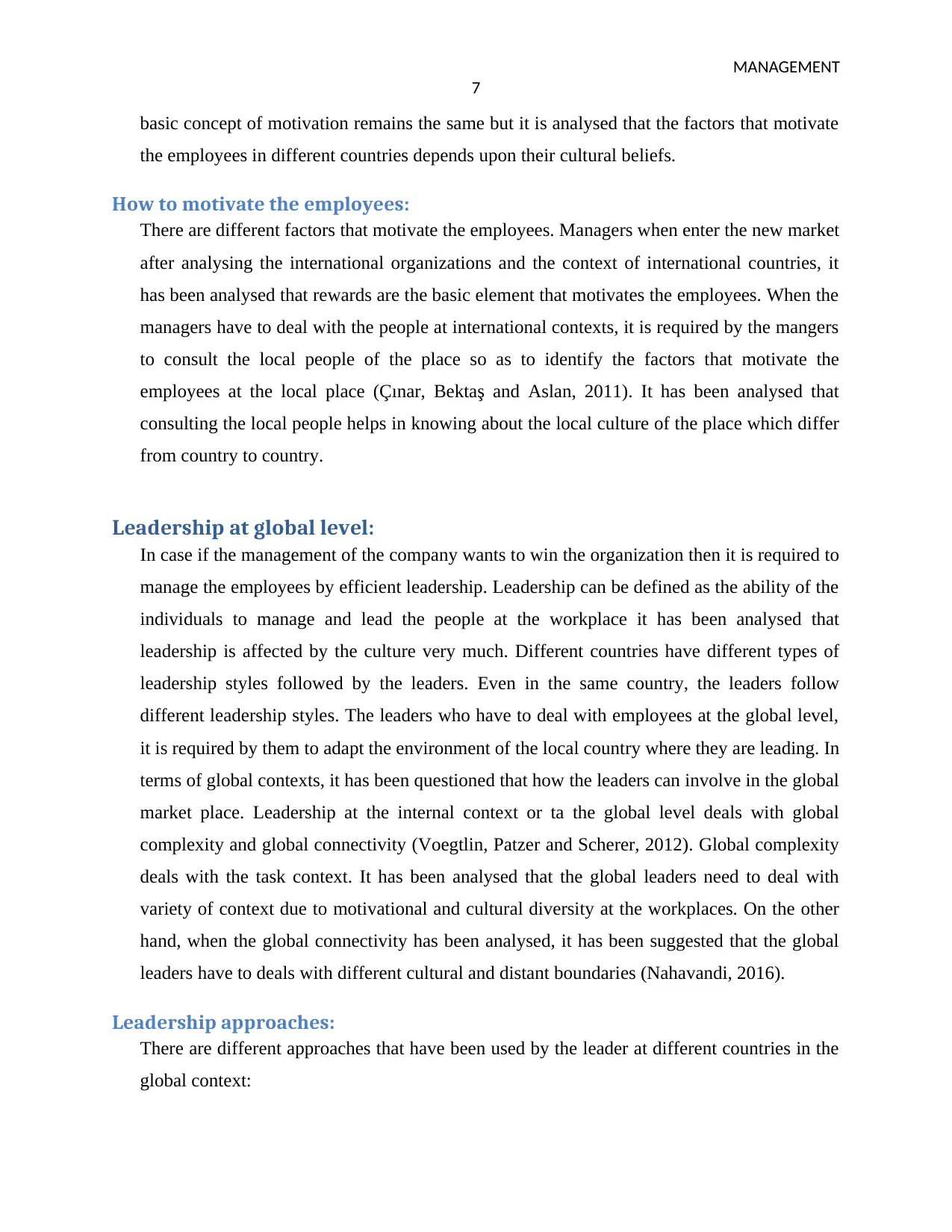
MANAGEMENT
7
basic concept of motivation remains the same but it is analysed that the factors that motivate
the employees in different countries depends upon their cultural beliefs.
How to motivate the employees:
There are different factors that motivate the employees. Managers when enter the new market
after analysing the international organizations and the context of international countries, it
has been analysed that rewards are the basic element that motivates the employees. When the
managers have to deal with the people at international contexts, it is required by the mangers
to consult the local people of the place so as to identify the factors that motivate the
employees at the local place (Çınar, Bektaş and Aslan, 2011). It has been analysed that
consulting the local people helps in knowing about the local culture of the place which differ
from country to country.
Leadership at global level:
In case if the management of the company wants to win the organization then it is required to
manage the employees by efficient leadership. Leadership can be defined as the ability of the
individuals to manage and lead the people at the workplace it has been analysed that
leadership is affected by the culture very much. Different countries have different types of
leadership styles followed by the leaders. Even in the same country, the leaders follow
different leadership styles. The leaders who have to deal with employees at the global level,
it is required by them to adapt the environment of the local country where they are leading. In
terms of global contexts, it has been questioned that how the leaders can involve in the global
market place. Leadership at the internal context or ta the global level deals with global
complexity and global connectivity (Voegtlin, Patzer and Scherer, 2012). Global complexity
deals with the task context. It has been analysed that the global leaders need to deal with
variety of context due to motivational and cultural diversity at the workplaces. On the other
hand, when the global connectivity has been analysed, it has been suggested that the global
leaders have to deals with different cultural and distant boundaries (Nahavandi, 2016).
Leadership approaches:
There are different approaches that have been used by the leader at different countries in the
global context:
7
basic concept of motivation remains the same but it is analysed that the factors that motivate
the employees in different countries depends upon their cultural beliefs.
How to motivate the employees:
There are different factors that motivate the employees. Managers when enter the new market
after analysing the international organizations and the context of international countries, it
has been analysed that rewards are the basic element that motivates the employees. When the
managers have to deal with the people at international contexts, it is required by the mangers
to consult the local people of the place so as to identify the factors that motivate the
employees at the local place (Çınar, Bektaş and Aslan, 2011). It has been analysed that
consulting the local people helps in knowing about the local culture of the place which differ
from country to country.
Leadership at global level:
In case if the management of the company wants to win the organization then it is required to
manage the employees by efficient leadership. Leadership can be defined as the ability of the
individuals to manage and lead the people at the workplace it has been analysed that
leadership is affected by the culture very much. Different countries have different types of
leadership styles followed by the leaders. Even in the same country, the leaders follow
different leadership styles. The leaders who have to deal with employees at the global level,
it is required by them to adapt the environment of the local country where they are leading. In
terms of global contexts, it has been questioned that how the leaders can involve in the global
market place. Leadership at the internal context or ta the global level deals with global
complexity and global connectivity (Voegtlin, Patzer and Scherer, 2012). Global complexity
deals with the task context. It has been analysed that the global leaders need to deal with
variety of context due to motivational and cultural diversity at the workplaces. On the other
hand, when the global connectivity has been analysed, it has been suggested that the global
leaders have to deals with different cultural and distant boundaries (Nahavandi, 2016).
Leadership approaches:
There are different approaches that have been used by the leader at different countries in the
global context:
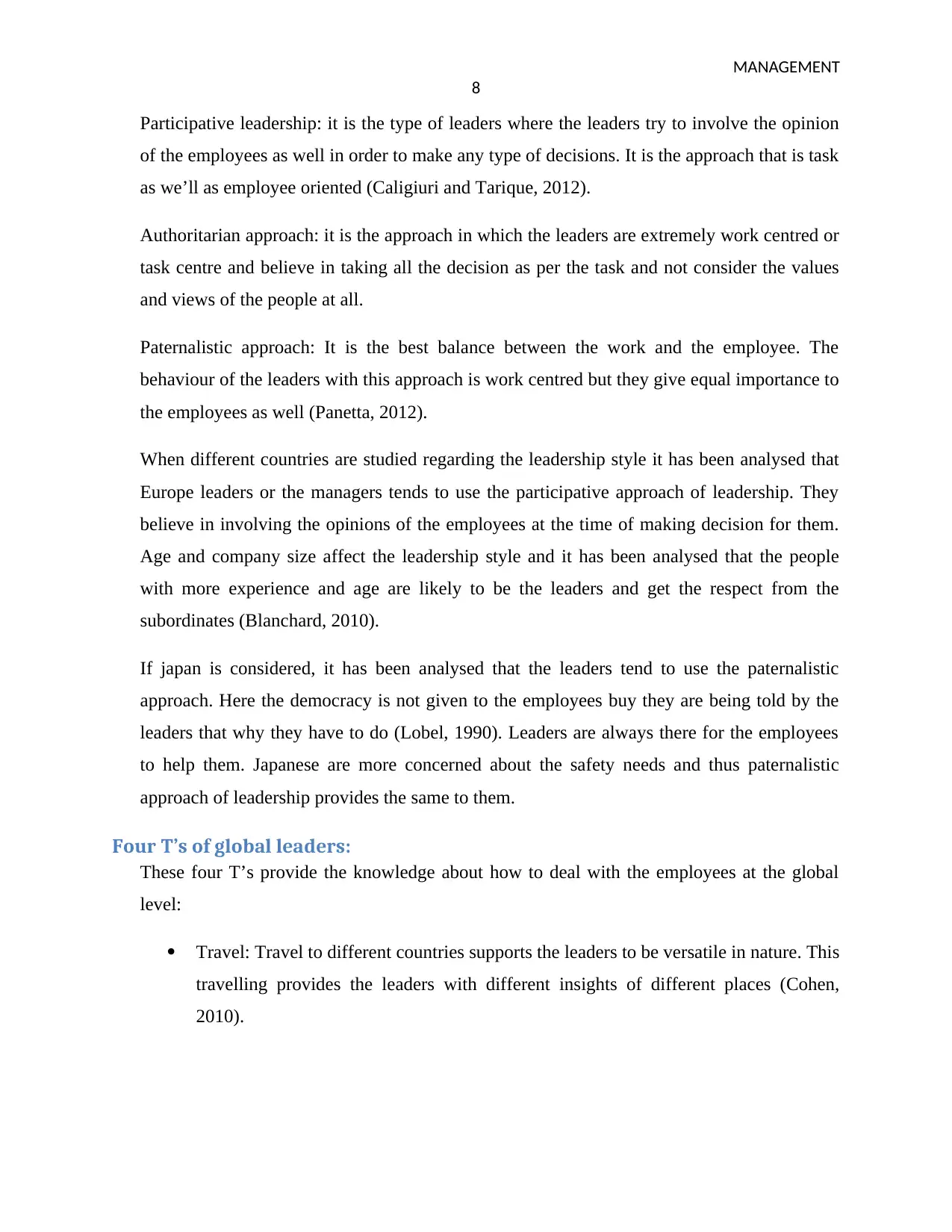
MANAGEMENT
8
Participative leadership: it is the type of leaders where the leaders try to involve the opinion
of the employees as well in order to make any type of decisions. It is the approach that is task
as we’ll as employee oriented (Caligiuri and Tarique, 2012).
Authoritarian approach: it is the approach in which the leaders are extremely work centred or
task centre and believe in taking all the decision as per the task and not consider the values
and views of the people at all.
Paternalistic approach: It is the best balance between the work and the employee. The
behaviour of the leaders with this approach is work centred but they give equal importance to
the employees as well (Panetta, 2012).
When different countries are studied regarding the leadership style it has been analysed that
Europe leaders or the managers tends to use the participative approach of leadership. They
believe in involving the opinions of the employees at the time of making decision for them.
Age and company size affect the leadership style and it has been analysed that the people
with more experience and age are likely to be the leaders and get the respect from the
subordinates (Blanchard, 2010).
If japan is considered, it has been analysed that the leaders tend to use the paternalistic
approach. Here the democracy is not given to the employees buy they are being told by the
leaders that why they have to do (Lobel, 1990). Leaders are always there for the employees
to help them. Japanese are more concerned about the safety needs and thus paternalistic
approach of leadership provides the same to them.
Four T’s of global leaders:
These four T’s provide the knowledge about how to deal with the employees at the global
level:
Travel: Travel to different countries supports the leaders to be versatile in nature. This
travelling provides the leaders with different insights of different places (Cohen,
2010).
8
Participative leadership: it is the type of leaders where the leaders try to involve the opinion
of the employees as well in order to make any type of decisions. It is the approach that is task
as we’ll as employee oriented (Caligiuri and Tarique, 2012).
Authoritarian approach: it is the approach in which the leaders are extremely work centred or
task centre and believe in taking all the decision as per the task and not consider the values
and views of the people at all.
Paternalistic approach: It is the best balance between the work and the employee. The
behaviour of the leaders with this approach is work centred but they give equal importance to
the employees as well (Panetta, 2012).
When different countries are studied regarding the leadership style it has been analysed that
Europe leaders or the managers tends to use the participative approach of leadership. They
believe in involving the opinions of the employees at the time of making decision for them.
Age and company size affect the leadership style and it has been analysed that the people
with more experience and age are likely to be the leaders and get the respect from the
subordinates (Blanchard, 2010).
If japan is considered, it has been analysed that the leaders tend to use the paternalistic
approach. Here the democracy is not given to the employees buy they are being told by the
leaders that why they have to do (Lobel, 1990). Leaders are always there for the employees
to help them. Japanese are more concerned about the safety needs and thus paternalistic
approach of leadership provides the same to them.
Four T’s of global leaders:
These four T’s provide the knowledge about how to deal with the employees at the global
level:
Travel: Travel to different countries supports the leaders to be versatile in nature. This
travelling provides the leaders with different insights of different places (Cohen,
2010).
⊘ This is a preview!⊘
Do you want full access?
Subscribe today to unlock all pages.

Trusted by 1+ million students worldwide
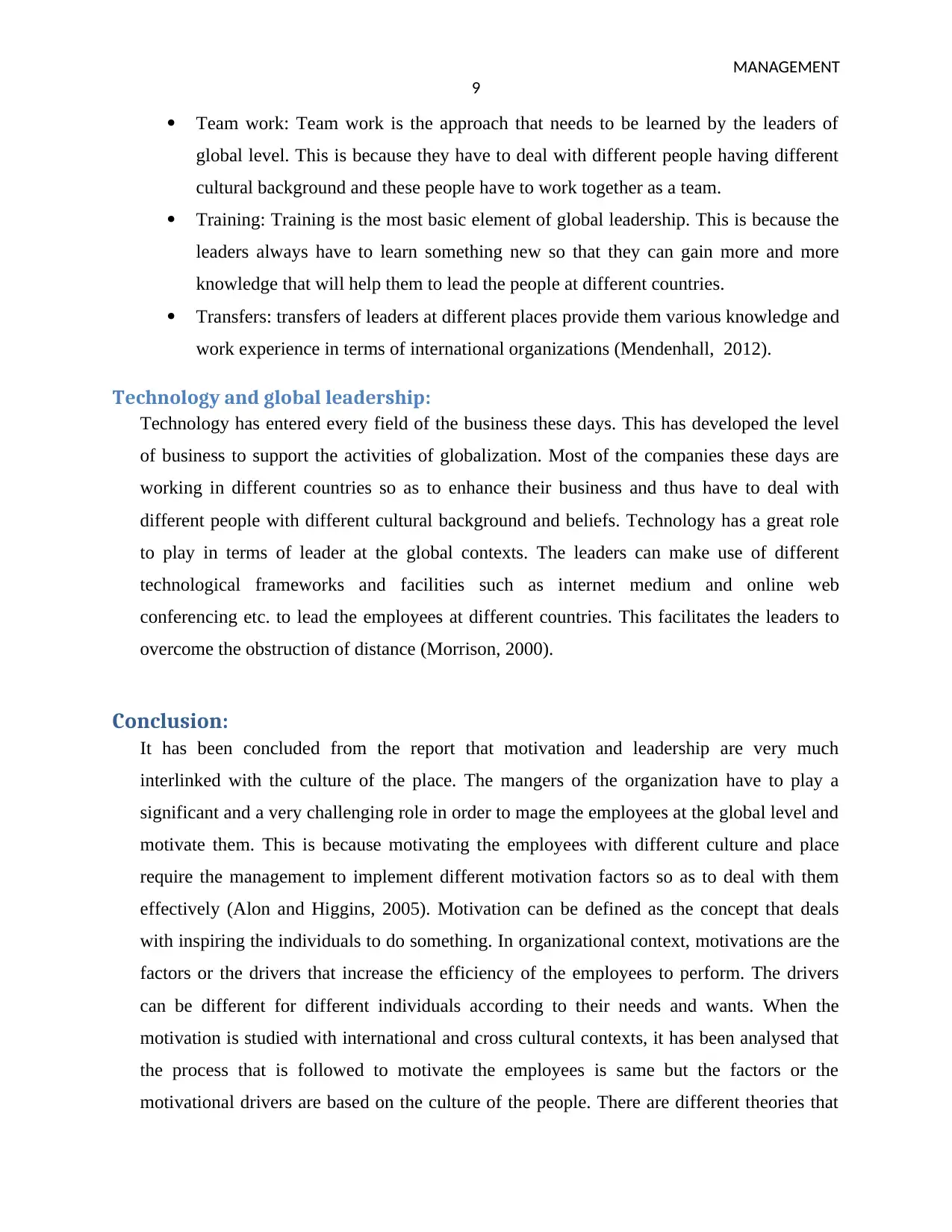
MANAGEMENT
9
Team work: Team work is the approach that needs to be learned by the leaders of
global level. This is because they have to deal with different people having different
cultural background and these people have to work together as a team.
Training: Training is the most basic element of global leadership. This is because the
leaders always have to learn something new so that they can gain more and more
knowledge that will help them to lead the people at different countries.
Transfers: transfers of leaders at different places provide them various knowledge and
work experience in terms of international organizations (Mendenhall, 2012).
Technology and global leadership:
Technology has entered every field of the business these days. This has developed the level
of business to support the activities of globalization. Most of the companies these days are
working in different countries so as to enhance their business and thus have to deal with
different people with different cultural background and beliefs. Technology has a great role
to play in terms of leader at the global contexts. The leaders can make use of different
technological frameworks and facilities such as internet medium and online web
conferencing etc. to lead the employees at different countries. This facilitates the leaders to
overcome the obstruction of distance (Morrison, 2000).
Conclusion:
It has been concluded from the report that motivation and leadership are very much
interlinked with the culture of the place. The mangers of the organization have to play a
significant and a very challenging role in order to mage the employees at the global level and
motivate them. This is because motivating the employees with different culture and place
require the management to implement different motivation factors so as to deal with them
effectively (Alon and Higgins, 2005). Motivation can be defined as the concept that deals
with inspiring the individuals to do something. In organizational context, motivations are the
factors or the drivers that increase the efficiency of the employees to perform. The drivers
can be different for different individuals according to their needs and wants. When the
motivation is studied with international and cross cultural contexts, it has been analysed that
the process that is followed to motivate the employees is same but the factors or the
motivational drivers are based on the culture of the people. There are different theories that
9
Team work: Team work is the approach that needs to be learned by the leaders of
global level. This is because they have to deal with different people having different
cultural background and these people have to work together as a team.
Training: Training is the most basic element of global leadership. This is because the
leaders always have to learn something new so that they can gain more and more
knowledge that will help them to lead the people at different countries.
Transfers: transfers of leaders at different places provide them various knowledge and
work experience in terms of international organizations (Mendenhall, 2012).
Technology and global leadership:
Technology has entered every field of the business these days. This has developed the level
of business to support the activities of globalization. Most of the companies these days are
working in different countries so as to enhance their business and thus have to deal with
different people with different cultural background and beliefs. Technology has a great role
to play in terms of leader at the global contexts. The leaders can make use of different
technological frameworks and facilities such as internet medium and online web
conferencing etc. to lead the employees at different countries. This facilitates the leaders to
overcome the obstruction of distance (Morrison, 2000).
Conclusion:
It has been concluded from the report that motivation and leadership are very much
interlinked with the culture of the place. The mangers of the organization have to play a
significant and a very challenging role in order to mage the employees at the global level and
motivate them. This is because motivating the employees with different culture and place
require the management to implement different motivation factors so as to deal with them
effectively (Alon and Higgins, 2005). Motivation can be defined as the concept that deals
with inspiring the individuals to do something. In organizational context, motivations are the
factors or the drivers that increase the efficiency of the employees to perform. The drivers
can be different for different individuals according to their needs and wants. When the
motivation is studied with international and cross cultural contexts, it has been analysed that
the process that is followed to motivate the employees is same but the factors or the
motivational drivers are based on the culture of the people. There are different theories that
Paraphrase This Document
Need a fresh take? Get an instant paraphrase of this document with our AI Paraphraser

MANAGEMENT
10
are related to motivation at the international contexts such as Hofstede theory, Maslow
hierarchical theory and toe factor theory of Herzberg. As far as the leadership is concerned, it
has been analysed that mangers who act the leaders at the global level has to follow the four
T's to be effective leaders those four T’s are training, team work, transfer and travel.
Technology has is role to play in helping the leaders to work at global contexts.
10
are related to motivation at the international contexts such as Hofstede theory, Maslow
hierarchical theory and toe factor theory of Herzberg. As far as the leadership is concerned, it
has been analysed that mangers who act the leaders at the global level has to follow the four
T's to be effective leaders those four T’s are training, team work, transfer and travel.
Technology has is role to play in helping the leaders to work at global contexts.
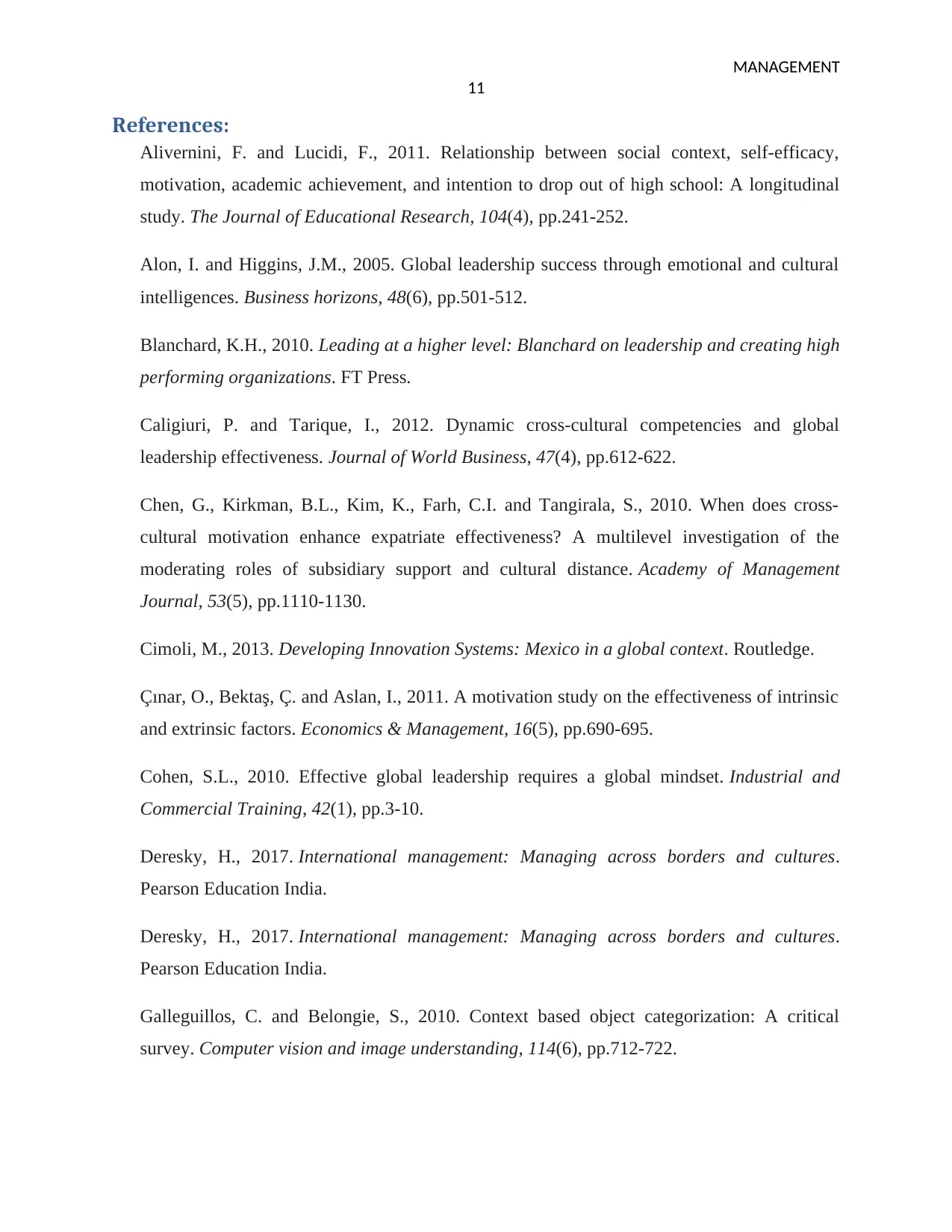
MANAGEMENT
11
References:
Alivernini, F. and Lucidi, F., 2011. Relationship between social context, self-efficacy,
motivation, academic achievement, and intention to drop out of high school: A longitudinal
study. The Journal of Educational Research, 104(4), pp.241-252.
Alon, I. and Higgins, J.M., 2005. Global leadership success through emotional and cultural
intelligences. Business horizons, 48(6), pp.501-512.
Blanchard, K.H., 2010. Leading at a higher level: Blanchard on leadership and creating high
performing organizations. FT Press.
Caligiuri, P. and Tarique, I., 2012. Dynamic cross-cultural competencies and global
leadership effectiveness. Journal of World Business, 47(4), pp.612-622.
Chen, G., Kirkman, B.L., Kim, K., Farh, C.I. and Tangirala, S., 2010. When does cross-
cultural motivation enhance expatriate effectiveness? A multilevel investigation of the
moderating roles of subsidiary support and cultural distance. Academy of Management
Journal, 53(5), pp.1110-1130.
Cimoli, M., 2013. Developing Innovation Systems: Mexico in a global context. Routledge.
Çınar, O., Bektaş, Ç. and Aslan, I., 2011. A motivation study on the effectiveness of intrinsic
and extrinsic factors. Economics & Management, 16(5), pp.690-695.
Cohen, S.L., 2010. Effective global leadership requires a global mindset. Industrial and
Commercial Training, 42(1), pp.3-10.
Deresky, H., 2017. International management: Managing across borders and cultures.
Pearson Education India.
Deresky, H., 2017. International management: Managing across borders and cultures.
Pearson Education India.
Galleguillos, C. and Belongie, S., 2010. Context based object categorization: A critical
survey. Computer vision and image understanding, 114(6), pp.712-722.
11
References:
Alivernini, F. and Lucidi, F., 2011. Relationship between social context, self-efficacy,
motivation, academic achievement, and intention to drop out of high school: A longitudinal
study. The Journal of Educational Research, 104(4), pp.241-252.
Alon, I. and Higgins, J.M., 2005. Global leadership success through emotional and cultural
intelligences. Business horizons, 48(6), pp.501-512.
Blanchard, K.H., 2010. Leading at a higher level: Blanchard on leadership and creating high
performing organizations. FT Press.
Caligiuri, P. and Tarique, I., 2012. Dynamic cross-cultural competencies and global
leadership effectiveness. Journal of World Business, 47(4), pp.612-622.
Chen, G., Kirkman, B.L., Kim, K., Farh, C.I. and Tangirala, S., 2010. When does cross-
cultural motivation enhance expatriate effectiveness? A multilevel investigation of the
moderating roles of subsidiary support and cultural distance. Academy of Management
Journal, 53(5), pp.1110-1130.
Cimoli, M., 2013. Developing Innovation Systems: Mexico in a global context. Routledge.
Çınar, O., Bektaş, Ç. and Aslan, I., 2011. A motivation study on the effectiveness of intrinsic
and extrinsic factors. Economics & Management, 16(5), pp.690-695.
Cohen, S.L., 2010. Effective global leadership requires a global mindset. Industrial and
Commercial Training, 42(1), pp.3-10.
Deresky, H., 2017. International management: Managing across borders and cultures.
Pearson Education India.
Deresky, H., 2017. International management: Managing across borders and cultures.
Pearson Education India.
Galleguillos, C. and Belongie, S., 2010. Context based object categorization: A critical
survey. Computer vision and image understanding, 114(6), pp.712-722.
⊘ This is a preview!⊘
Do you want full access?
Subscribe today to unlock all pages.

Trusted by 1+ million students worldwide
1 out of 14
Related Documents
Your All-in-One AI-Powered Toolkit for Academic Success.
+13062052269
info@desklib.com
Available 24*7 on WhatsApp / Email
![[object Object]](/_next/static/media/star-bottom.7253800d.svg)
Unlock your academic potential
Copyright © 2020–2025 A2Z Services. All Rights Reserved. Developed and managed by ZUCOL.





